AREA OF TRIANGLE USING SINE FORMULA
Subscribe to our ▶️ YouTube channel 🔴 for the latest videos, updates, and tips.
Area of the triangle is a half of product of two sides and the side included angle.
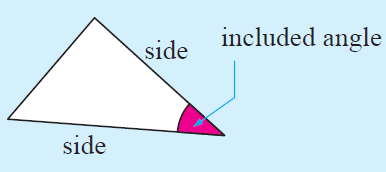
Consider the triangle given below, in which the sides opposite angles A, B and C are labelled a, b and c respectively.
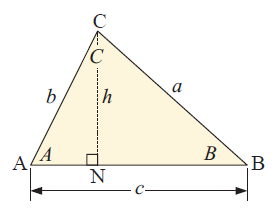
In the triangle given above
AB = c (base) and
CN = h(height)
In triangle ANC,
sin A = Opposite side / hypotenuse
sin A = h/b
h = b (sin A)
So, area of triangle ABC = (1/2) ⋅ base ⋅ height
= (1/2) ⋅ c ⋅ (b sin A)
Area of triangle = (1/2) ⋅ (bc sin A)
Find the area of the triangle given below :
Example 1 :
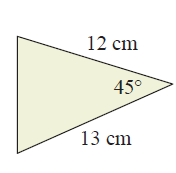
Solution :
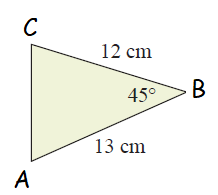
<B = 45, a = 12 cm and c = 13 cm.
Area of triangle = (1/2) ⋅ (ac sin B)
= (1/2) ⋅ (13) ⋅ (12) sin 45
= (1/2) ⋅ (13) ⋅ (12) (0.707)
= 55.146 cm2
Example 2 :
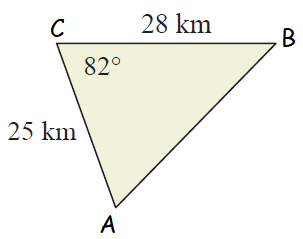
Solution :
<C = 82, a = 28 km and c = 25 km
Area of triangle = (1/2) ⋅ (ac sin C)
= (1/2) ⋅ (28) ⋅ (25) sin 82
= (1/2) ⋅ (28) ⋅ (25) (0.990)
= 346.5 km2
So, the area of the given triangle is 347 km2.
Example 3 :
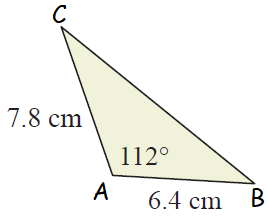
Solution :
<A = 112, c = 6.4 cm and b = 7.8 cm
Area of triangle = (1/2) ⋅ (bc sin A)
= (1/2) ⋅ (7.8) ⋅ (6.4) sin 112
= (1/2) ⋅ (7.8) ⋅ (6.4) (0.927)
= 23.13 cm2
So, the area of the given triangle is 23.13 cm2.
Example 4 :
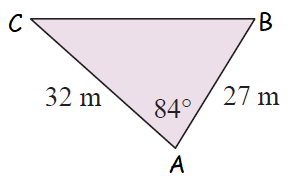
Solution :
<A = 84, b = 32 m and c = 27 m
Area of triangle = (1/2) ⋅ (bc sin A)
= (1/2) ⋅ (32) ⋅ (27) sin 84
= (1/2) ⋅ (32) ⋅ (27) (0.994)
= 429.40 m2
So, the area of the given triangle is 430 cm2.
Example 5 :
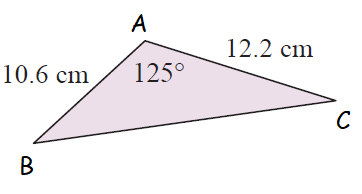
Solution :
<A = 125, b = 12.2 cm and c = 10.6 cm
Area of triangle = (1/2) ⋅ (bc sin A)
= (1/2) ⋅ (12.2) ⋅ (10.6) sin 125
= (1/2) ⋅ (12.2) ⋅ (10.6) (0.819)
= 52.95 cm2
So, the area of the given triangle is 53cm2.
Example 6 :
Find the area of a parallelogram with sides 6.4 cm and 8.7 cm and one interior angle 64o.
Solution :
In a parallelogram, opposite angles are equal and opposite sides are equal.
So, by drawing the diagonal we can divide the parallelogram into two triangles of equal area.
<A = 64, b = 6.4 cm and c = 8.7 cm
Area of triangle = (1/2) ⋅ (bc sin A)
= (1/2) ⋅ (6.4) (8.7) sin 64
= (1/2) ⋅ (6.4) (8.7) (0.898)
= 25
Area of parallelogram = 2(25)
= 50 cm2
Problem 7 :
If triangle ABC has area 150 cm2, find the value of x.
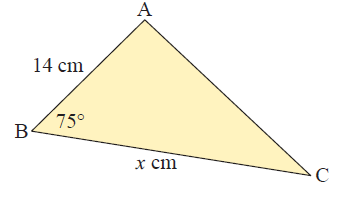
Solution :
<B = 75, a = x cm and c = 14 cm
Area of triangle = (1/2) ⋅ (ac sin B)
= (1/2) ⋅ (x) (14) sin 75
= 7x (0.965)
= 6.755x
6.755x = 150
x = 150/6.755
x = 22.2 cm
So, the value of x is 22.2 cm.
Problem 8 :
A parallelogram has two adjacent sides with lengths 4 cm and 6 cm respectively. If the included angle measures 52 degree, find the area of the parallelogram.
Solution :
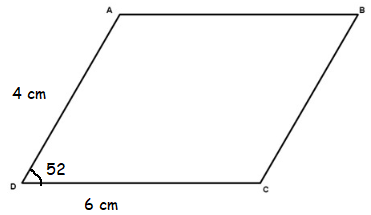
Area of triangle = (1/2) ⋅ (ac sin B)
here a = 6 cm, c = 4 cm and B = 52
= (1/2) ⋅ (6) (4) sin 52
= 12 sin 52
= 12(0.788)
= 9.456
Area of parallelogram = 9.456(2)
= 18.912 cm2
So, the required area of parallelogram is 18.9 cm2
Problem 9 :
A rhombus has sides of length 12 cm and an angle of 72 degree. Find its area.
Solution :
Since the given shape is a rhombus, all sides will be equal. By finding area of one triangle and multiplying the result by 2, we will get area of rhombus.
Area of triangle = 1/2 x 12 x 12 x sin 72
= 72 sin 72
= 72(0.951)
= 68.472 cm2
Area of rhombus = 2(68.472)
= 136.944 cm2
Problem 10 :

Shows a shape ABC in which AOB is a triangle, AOC is a straight line and OBC is a sector of a circle with centre O. AO = 10 cm, OC = OB = 6 cm and the length of arc BC = π cm. Find, to 3 significant figures
(a) the length of AB
(b) the area of the shape ABC.
Solution :
a)
Length of arc = (θ/360) x 2πr
radius = 6 cm
π = (θ/360) x 2π(6)
1 = (θ/360) x 12
1 = (θ/30)
θ = 30
<AOB = 180 - 30
= 150
AB2 = OA2 + OB2 - 2 (OA)(OB) cos 150
AB2 = 102 + 62 - 2 (10)(6) cos 150
= 100 + 36 - 120(-0.866)
= 136 + 103.92
= √239.92
AB = 15.5 cm
b) Area of ABC = Area of triangle AOB + area of OBC
Area of triangle = (1/2) x b x c sin θ
Area of sector OBC = (θ/360) x πr2
= (1/2) x 10 x 6 x sin 150 + (30/360) x 3.14 x 62
= 30 (0.5) + 9.42
= 15 + 9.42
= 24.42
Problem 11 :
A rhombus has an area of 50 cm2 and an internal angle of size 63 degree. Find the length of its sides.
Solution :
Area of rhombus
= 2 x (1/2) product of adjacent sides x sin θ
For a rhombus, all sides will be equal.
50 = a2 x sin 63
50 / sin 63 = a2
50/0.89 = a2
a2 = 56.17
a = √56.17
a = 7.49
a = 7.5 cm
So, side length of rhombus is 7.5 cm.
Subscribe to our ▶️ YouTube channel 🔴 for the latest videos, updates, and tips.
Kindly mail your feedback to v4formath@gmail.com
We always appreciate your feedback.
About Us | Contact Us | Privacy Policy
©All rights reserved. onlinemath4all.com
Recent Articles
-
10 Hard SAT Math Questions (Part - 40)
Dec 18, 25 06:27 PM
10 Hard SAT Math Questions (Part - 40) -
Digital SAT Math Problems and Solutions (Part - 13)
Dec 18, 25 12:26 PM
Digital SAT Math Problems and Solutions (Part - 13) -
90 Degree Clockwise Rotation
Dec 18, 25 09:42 AM
90 Degree Clockwise Rotation - Rule - Examples with step by step explanation

